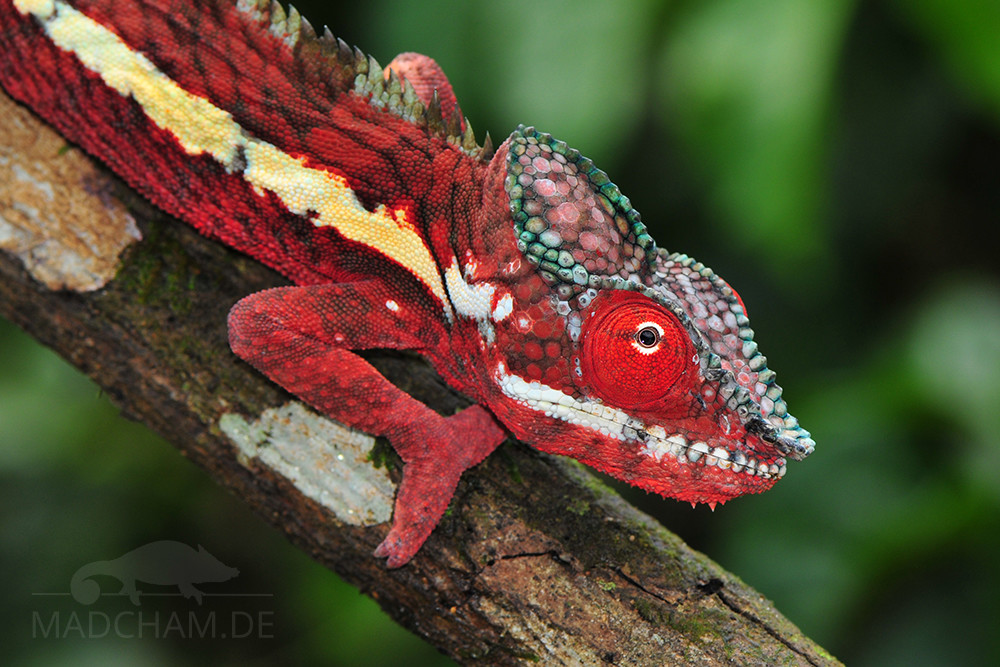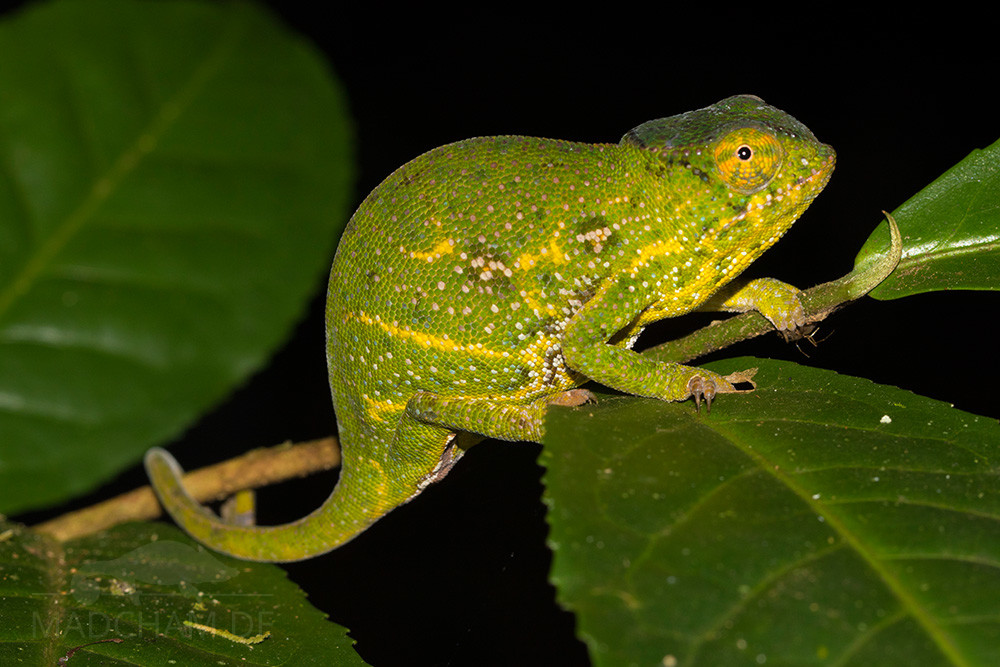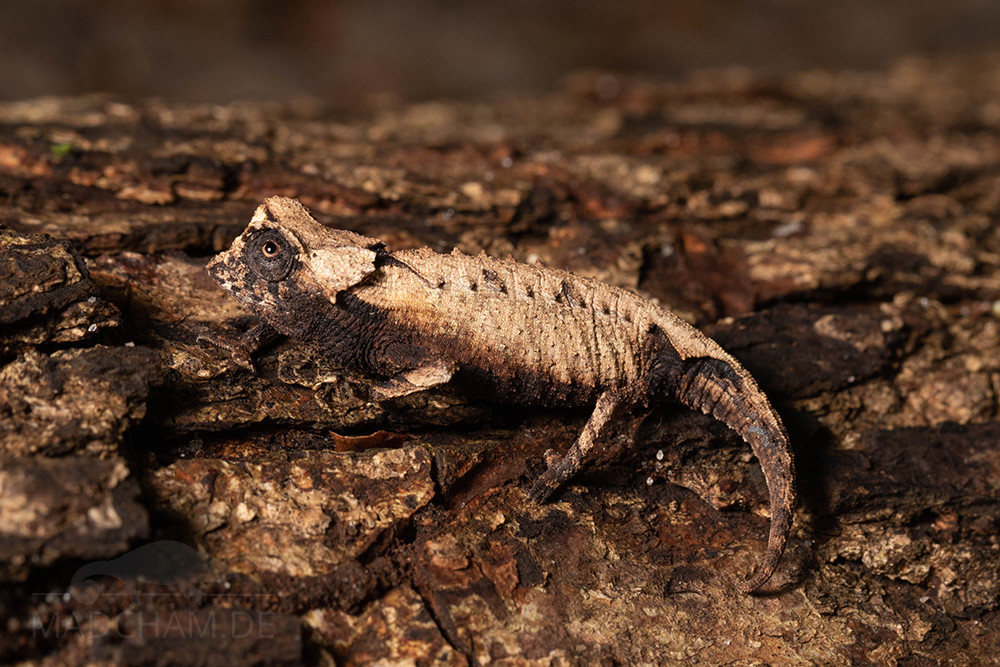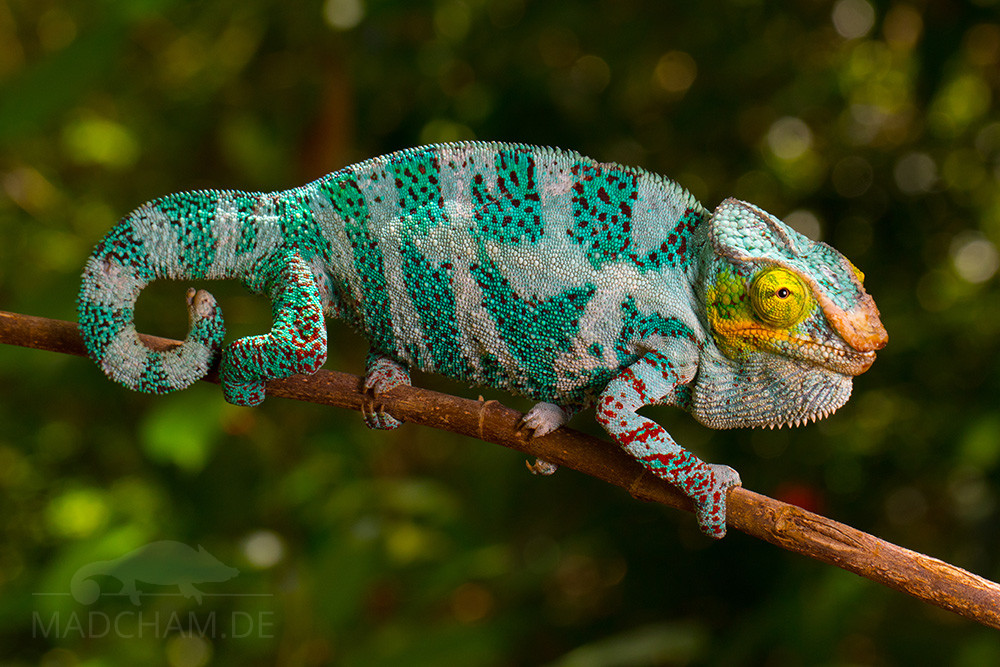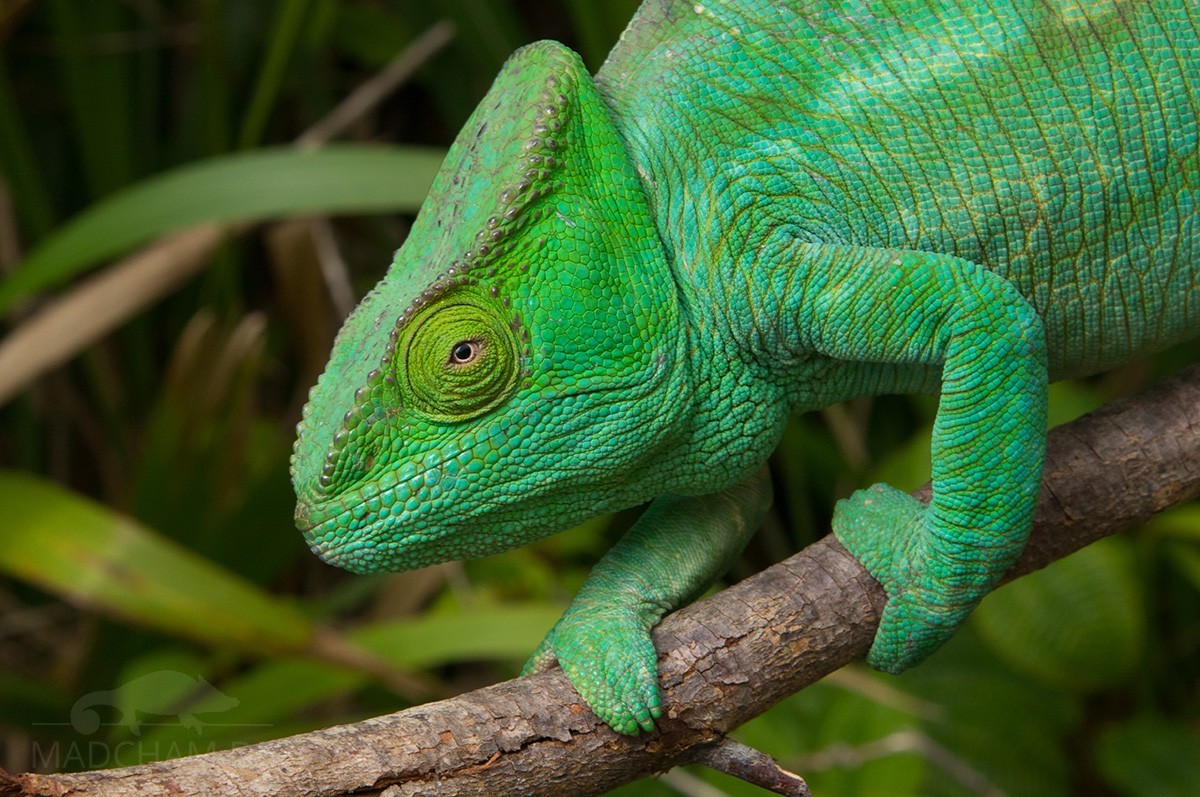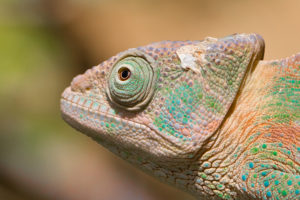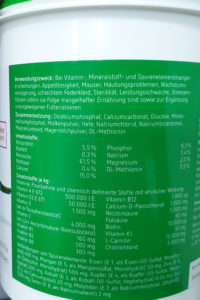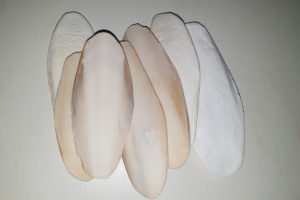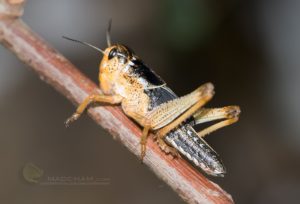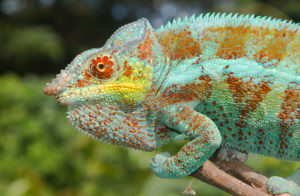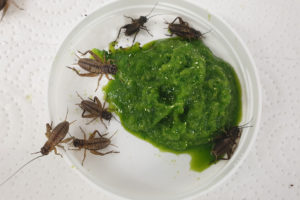Supplementation or supplementation in terraristics means that a feeder is dusted (powdered) with vitamin or calcium powder before feeding it to a chameleon. The intention is that a given amount of vitamins and calcium will end up in the chameleon’s digestive tract along with the feeder insect. Thus, it is an alternative to gutloading, which involves feeding the feeder animal special diets prior to feeding the chameleon. The word supplement comes from the Latin supplementum, which means “to add”.
Inhaltsverzeichnis
Why supplementation or gutloading?
In the early days of terraristics, supplementation was necessary simply because artificial UV-B radiation could not be offered. The appropriate lamps simply did not exist yet. UV-B is important for the formation of vitamin D3, which, simply put, enables the incorporation of calcium into the bones. In the meantime UV-B lamps belong to the standard in the terrarium hobby, however, the measuring of the lamps and thus a really steady supply with UV-B is often not given. Today, therefore, both UV-B radiation and supplementation are used to keep chameleons healthy. Studies on chameleons have shown that a combination of UV-B irradiation, gutloading, and supplementation of the feeders gives the best result to prevent diseases like metabolic bone disease.
Although a wide range of feeders is available nowadays, most chameleons are only given a few different insects as food – mostly for very practical reasons. Most insects used as food animals in terraristics also do not contain very much calcium and vitamin A. Crickets even contain less than 1 IU of vitamin A per gram of insect, according to one study. IU is the abbreviation for international units. However, both calcium and vitamin A are necessary to keep a chameleon healthy. To make up for the deficiency in insects, you need to either supplement or gutload the feeders.
The roles of calcium, phosphate, and vitamin D 3 and their interaction in the body are explained in detail on this page. Vitamin A is required by chameleons, as by other reptiles, for skin, growth, reproduction, vision, and the immune system. An undersupply (hypovitaminosis) leads, among other things, to blepharoedema and molting difficulties. An oversupply (hypervitaminosis) can also be problematic. Studies have also shown that certain vitamins may also be important for well-being, sexual behavior, and reproduction, as well as health. Supplementation of vitamin E, for example, provides an increased release of vitamin E from the femoral pores of males in green lizards (Lacerta viridis), making them more attractive to females. Supplementation of vitamin D achieves higher attractiveness to females in mountain lizards (Lacerta monticola). Unfortunately, such studies are still pending for chameleons.
Advantages and disadvantages of supplementation
The advantages and disadvantages of supplementation compared to gutloading are explained in detail in this article. Therefore, the entire text section is not repeated here.
Vitamin supplements
Pet shops offer a plethora of preparations in colorful cans and packaging. Many of them are useless, some per se unsuitable for chameleons. Basically, a vitamin preparation should not only contain one vitamin but vitamins A, B, C, D, E, and K as well as trace elements (selenium, iodine). In general, liquid vitamin preparations should be avoided. Vitamins do not dissolve evenly in the liquids used and deteriorate quickly. With liquid preparations, it is therefore not guaranteed that the chameleon also receives sufficient vitamins. If the water offered tastes different, the chameleon may change its drinking habits in the worst case.
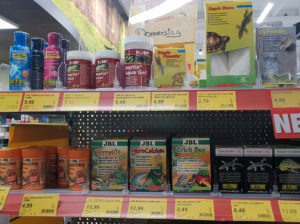
A shelf full of vitamin and calcium supplements in a pet store
With vitamin powders, care should be taken to ensure that the powder adheres well to the feeders. If it adheres poorly, not enough powder will reach the chameleon. Incidentally, adhesion also varies depending on the insect species and size. Vitamin powder adheres better to fruit flies than to grasshoppers or crickets, and it adheres better to young crickets than to adults.
How much of which vitamin?
First of all: There are still no studies that have investigated the exact amounts of vitamins needed by chameleons. So if you are looking for exact recommendation on what to use for your chameleon, you are better off in the section “Recommended vitamin preparations”. But there are many indications from the practice of veterinarians, keepers, and studies that deal with approximations of the optimal supplementation. So currently there are no set guidelines, only suggestions for providing chameleons with certain vitamins.
Vitamin A
The precursor of vitamin A is beta-carotene. Beta-carotene is found primarily in plants. It is suspected that most chameleons cannot metabolize this precursor to vitamin A themselves, or only in insufficient amounts. It, therefore, makes sense to use preformed vitamin A in supplements in the form of retinyl acetate or retinyl palmitate for chameleons. Both are so-called retinol esters.
In 1992 and 1993, John Annis published several articles in the Chameleon Information Network (CiN) about vitamin A overdose. At that time, before the Internet, magazines were the only way for keepers to get in touch with like-minded people and learn about chameleons. Unfortunately, the articles led to chameleon keepers becoming afraid of overdosing on vitamin A. They began supplementing the vitamin sometimes less, sometimes not at all anymore. This led to increased cases of hypovitaminosis A, or vitamin A deficiency, in chameleons in the following years and an increase in these cases in veterinary practices. Today, chameleons are more likely to have an undersupply of vitamin A, while oversupplies are very rare.
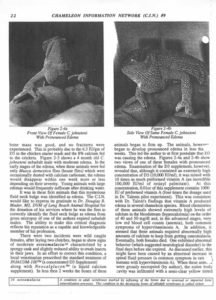
One of the articles in CiN after which keepers only sparingly supplemented with vitamin A
According to Mader, the current veterinary recommendation for regular supplementation of chameleons is up to 60,000 IU vitamin A per kg vitamin powder (in dry matter). Stahl instead suggests only 5000 to 10,000 IU per kg of vitamin powder. More interesting than these recommendations, however, are values that estimate the amount of vitamin A needed in relation to the bodyweight of the chameleon. Ferguson suggests 1-2 IU of vitamin A per gram of body weight of the chameleon per week. Only with this value, it is possible to calculate the required amount of vitamin preparation for an individual chameleon by oneself. If you want to – reputable manufacturers already give dosage recommendations.
Vitamin D3
For vitamin D3, the veterinary recommendation according to Mader for steady supplementation is 200-2000 IU, maximally 5000 IU per kg of vitamin powder (in dry matter). It is important to make sure that it really is vitamin D3. If a vitamin preparation contains only vitamin D, it may just as well be vitamin D2. However, this is useless for reptiles.
A 2010 study by Hoby et al. found that daily supplementation of 250,000 IU of vitamin A per kg of vitamin powder along with 25,000 IU of vitamin D3 per kg of vitamin powder produced the best results when it came to preventing metabolic bone disease. In the study, the chameleons also received at least ten hours per day of UV-B radiation in relatively small terrariums. They were also given feeders fed a gutloading diet containing 12% calcium. That means, under these conditions, the above vitamin amounts were appropriate. Under other husbandry conditions, for example, less UV-B radiation, this is not necessarily true.
Boyer and Scott recommend a ratio of vitamin A to vitamin D3 of approximately 10:1. This recommendation is implemented in many vitamin supplements, but not all.
Other vitamins
Vitamin B represents a group of eight very different vitamins that are precursors for coenzymes. Vitamin B1 is thiamine, B2 riboflavin, B3 nicotinic acid, B5 pantothenic acid, B6 pyridoxine, B7 biotin, B9 or B11 is folic acid, and vitamin B12 cobalamin. As coenzymes, B vitamins are necessary for the function of countless metabolic reactions in the body. An “excess” of vitamin B in the chameleon body is simply excreted again via the kidneys. Vitamin B can therefore practically not be overdosed.
Vitamin C (ascorbic acid) is an antioxidant, involved in the formation of collagen and various amino acids and important for the immune system. Like vitamin B, it cannot overdose practically because it is water-soluble. Chameleons can probably produce vitamin C themselves in the kidneys.
Vitamin E (tocopherol) is also an important antioxidant. It has an anti-inflammatory and anticoagulant effect, protects nerve cells, and promotes the immune system. For supplementation, use 20 to 80 IU of vitamin E per kg of vitamin powder, according to Mans and Braun. Boyer and Scott recommend a ratio between vitamin D3 and vitamin E of 10:1 (see also ratio of vitamin A to vitamin D3).
Information on the packaging
The production of vitamin preparation for reptiles should be carried out in a controlled manner according to the rules of the legislation of the respective country. In the European Union, for example, these are the regulations for the manufacture of supplementary feeds. Only this way can you be sure that the specified content amounts are also achieved. On the back of these preparations in the EU, you will find the words “supplementary feed” or “mineral feed” before the composition.
The manufacturer should disclose the composition, the ingredients in %, and the additives per kilogram of powder. The numbers should be either directly on the back of the preparation, or at least on the packaging. Some manufacturers list the ingredients only in tiny letters on the cans themselves, but not legibly on the packaging or in information brochures. With some preparations, you won’t even find a list of what’s actually in it on the manufacturer’s website.
Each can should have a best before date. Vitamins deteriorate relatively quickly when exposed to light and heat. You should be suspicious of manufacturers who cannot even give a best before date.
Dosage
The dosage of vitamin preparations should not be done accidentally, especially in the case of high-dose and thus effective preparations. Water-soluble vitamins (B, C) are excreted by the kidneys in excess, but fat-soluble vitamins (A, D, E, and K) are not. In the case of an overdose, fat-soluble vitamins can therefore lead to hypervitaminosis. Suitable vitamin preparations contain an exact dose recommendation from the manufacturer, for example in grams of powder per gram of insect. “Giving it through food” is too inaccurate. By weighing a few insects and the corresponding powder, it is easy to calculate the amount needed each week in the beginning. This will give you an overview of how much the chameleon needs per calculated period and you can dose the appropriate amounts. In case of doubt, a reptile veterinarian can also help with the dosage for the individual animal.
Storage and application
Vitamin preparations should always be stored in a container tightly closed, cool, dry and dark. Storage close to the cage lights or in front of a window with a high incidence of light and strong humidity is counterproductive. Freezing can extend the shelf life of vitamin preparations, but this is unsafe. Even well-stored vitamins will expire within a year. Better than freezing excess powder is to buy smaller units.
For application, you can put the feeders in a clean cricket box. Then add the required amount of vitamin powder and shake briefly and vigorously. After that, the feeders should be fed to your chameleon immediately. There are studies in which crickets had already cleaned half of the used vitamin powder from their bodies in less than two and a half minutes. Therefore: Shake and feed immediately, do not let it stand around.
Please always use vitamin and calcium supplements separately to ensure the dosages of both. Unused powder soiled by feeding animals or leftovers stuck in the box should be removed and not reused for the next feeding. Vitamin supplements that have exceeded the best-before date belong in the trash, not in the chameleon.
Recommended vitamin preparations
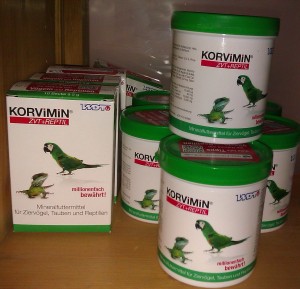
Korvimin® ZVT + Reptil in different sizes
For the supplementation of chameleons we currently recommend the following preparation:
Korvimin® ZVT + Reptil: Proven for decades, the only preparation manufactured by a pharmaceutical company in German-speaking countries. It can be purchased only through veterinarians. Not purchased through veterinarians (for example, on eBay or Amazon) the manufacturer no longer gives a guarantee. Korvimin® ZVT + Reptil has a relatively high dosage overall, but if the dosage is correct, under- or overdosing is not to be expected. According to the manufacturer, the recommended dosage for chameleons is 5 g of powder per 125 g of insects. The preparation is now also available in small 10g sachets and 50g sprinkle cans in addition to the 200g can.
Example: A 150 g panther chameleon receives 10-15 adult crickets per week. Each cricket weighs 0.8 to 1 g on average. For simplicity, let’s calculate 1 g per cricket and 10 crickets per week. These feeders would need to be dusted with 0.4 g of Korvimin® ZVT + Reptile per week before feeding them to the chameleon. At 200 IU of vitamin A per week, this is well within Ferguson’s recommendation. Vitamin A is in the form of retinyl acetate so that it can be utilized by the chameleon. The 10:1 ratio of vitamin A to vitamin D3 also fits. It does not matter whether the 0.4 g of Korvimin is supplemented to three or four crickets at the first feeding or whether it is divided into four times 0.1 g to two crickets. The main thing is that the 0.4 g ends up on the feed animals in the chameleon in one week.
Calcium supplements
The two most essential minerals in supplementation are calcium and phosphorus. Calcium is important for many vital processes in the body, such as skeletal growth, eggshell formation, and oviposition in females, or for muscle contraction (including tongue shot or any other movement). Phosphorus compounds are needed, among other things, for energy metabolism, bone formation, the buffer system of the blood, many coenzymes, and DNA. They are very versatile and essential for a chameleon. Both are closely related to vitamin D3, whose increased formation also increases calcium and phosphorus absorption via the intestine. In turn, a low level of vitamin D3 in the blood ensures increased phosphorus and calcium excretion via the kidneys.
According to Kölle and Scott, a calcium-phosphorus ratio of 2:1 should generally be aimed for in the diet of chameleons. Unfortunately, the calcium-phosphorus ratio of most food animals is not nearly as good. An adult cricket, for example, has a calcium-to-phosphorus ratio of 0.14 – that’s pretty far from 2. Therefore, calcium must generally be supplemented.
Although most vitamin supplements contain small amounts of calcium, this amount is not sufficient for the calcium supply of a chameleon. Therefore, vitamin powder and calcium are used alternately for supplementation. Caution: There are also calcium preparations to which vitamin D3 has been added. If you want to use these preparations, you have to use a vitamin powder with lower vitamin D3 and adjusted vitamin A content. It is easier and above all more suitable for beginners to use pure calcium powders without vitamin D3 in alternation with vitamin powders with vitamin D3.
Dosage
Calcium cannot be overdosed with food in a healthy chameleon. Excessive intakes are always related to the above-mentioned interactions with vitamin D3 and phosphate. Excess orally ingested calcium is simply excreted via feces in a healthy chameleon.
Recommended calcium supplements
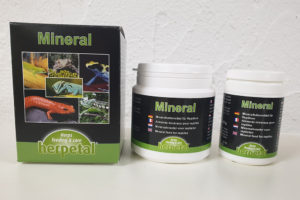
Herpetal Mineral in different sizes
Calcium can be supplemented in various ways. The easiest way is to boil eggshells and finely grind them after drying. Eggshell powder (ESP) consists of 35-40% calcium in the form of calcium carbonate. It is similarly easy to buy cuttlebones and grind them finely (white, not the pink coated shells from the pet bird store). Sepia is the bone of the squid and contains about 30% calcium. Pure calcium citrate or calcium carbonate (40% calcium) in powder form from the pharmacy is also suitable as a supplement. An example of a ready-made powder available in pet shops is Herpetal Mineral. According to the manufacturer, it contains 25.60% calcium.
Can I omit supplementation if I keep my chameleons outdoors?
When using self-caught feeders for outdoor husbandry in summer, supplementation can be dispensed within the best case. However, only if the chameleon can remain outside permanently and does not spend only “a few hours” in outdoor husbandry. In any case, it is safer to supplement outside in the summer, too.

